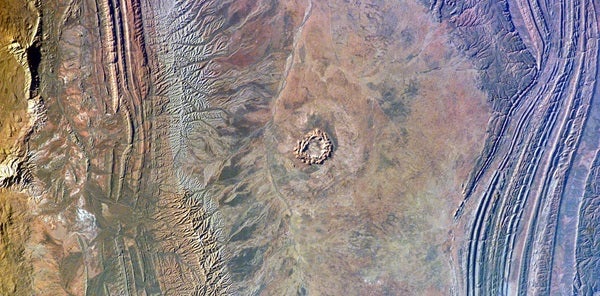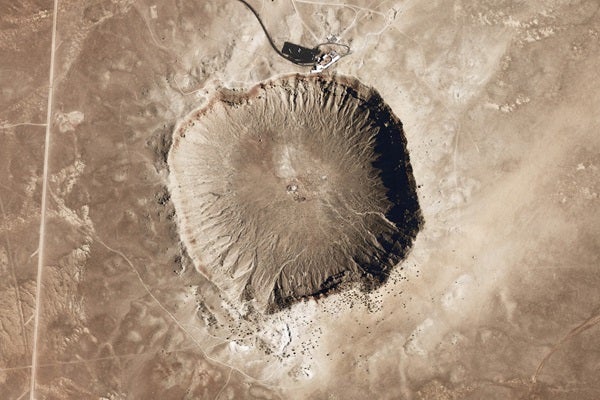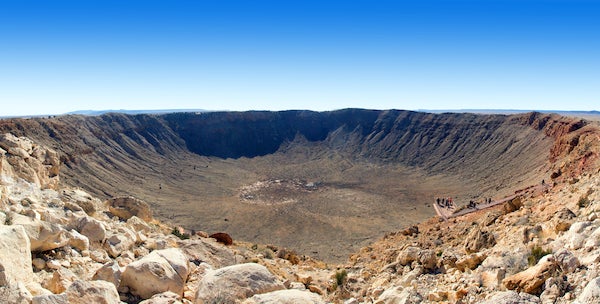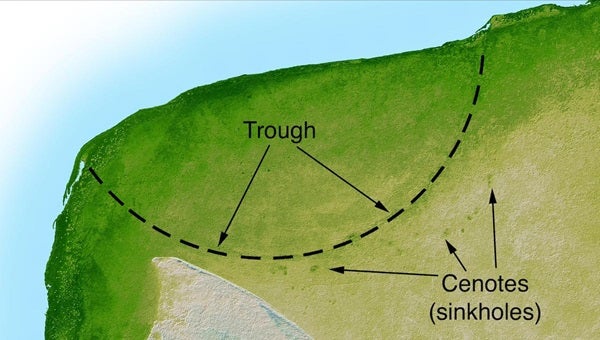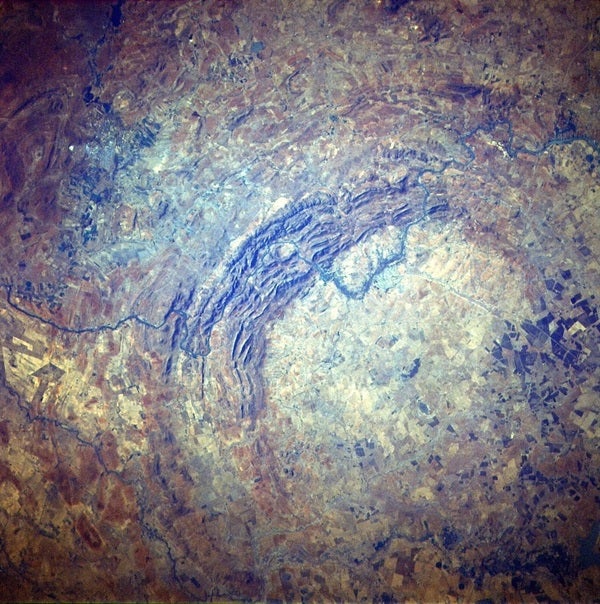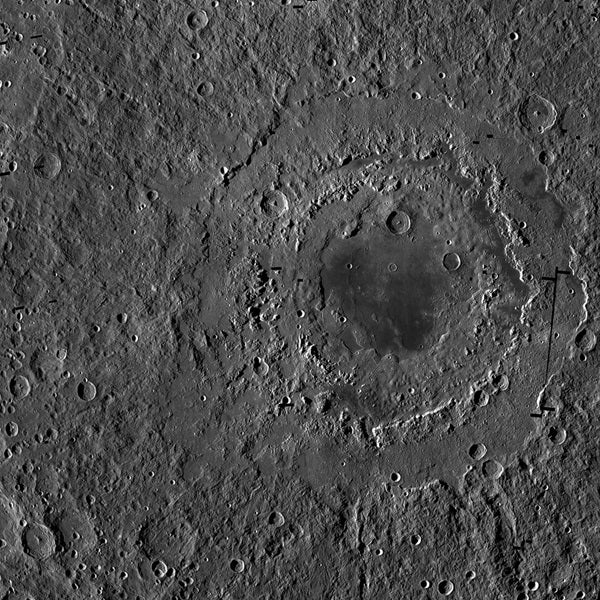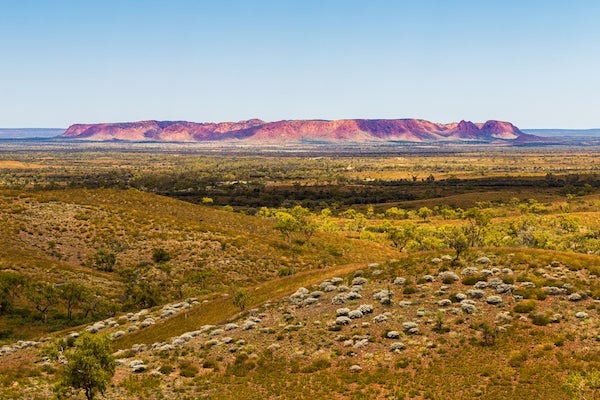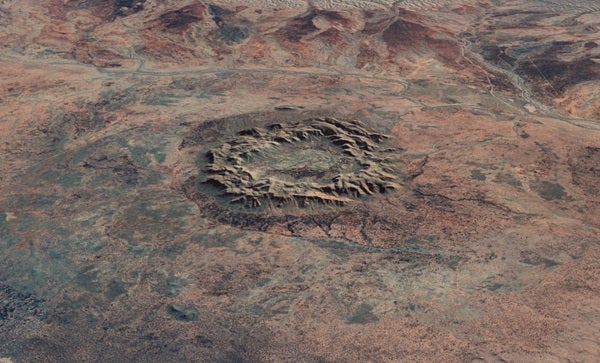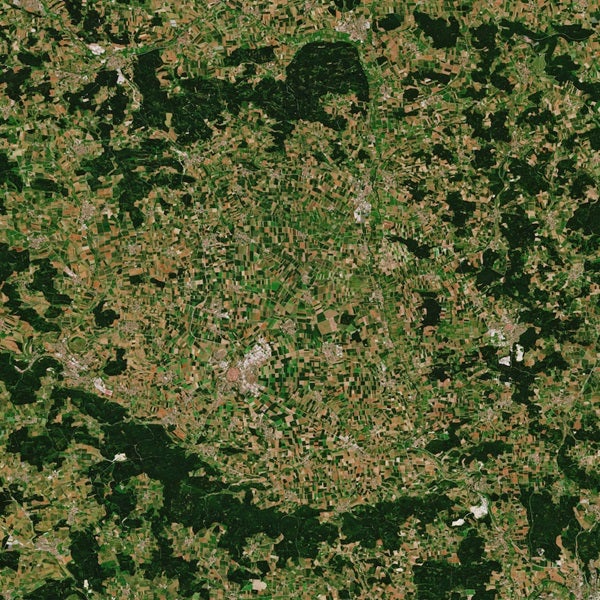I think all craters are cool, I’m just going to start with that. I am very biased.
Impact craters occur on every planetary body in our solar system, no matter the size. By studying impact craters and the meteorites that cause them, we can learn about the processes and the geology that shape our entire solar system.
This list contains some of my favorite impact craters down here on Earth.
1. Meteor Crater, AZ, US
A natural landmark
Barringer Crater (often called Meteor Crater), is located near the city of Winslow on Route 66 in Arizona, US, and was the first crater confirmed to have been caused by an extraterrestrial impact.
Meteor Crater is about 0.6 miles (1 km) in diameter and roughly 50,000 years old, making it relatively “young”. We’ve known about the crater since the late 19th century, but there was debate as to whether it was from an impact, or associated with the nearby volcanic province.
It wasn’t until the 1960s when high-pressure forms of quartz were identified in the rocks, together with meteorite fragments found nearby, that scientists could conclusively say it was a meteorite impact.
The crater is a site of active research. It is very well preserved, making it an excellent place to learn about the process of impact cratering. Since the early Apollo days, Meteor Crater has also been used to train astronauts. The practice continues to this day, with Artemis astronauts learning how to navigate terrains like those they will encounter on the lunar surface, as well as a bit of geology.
Today you can visit the crater (the gift shop is excellent!) and take a tour around the rim. It is a great addition to any trip to the Grand Canyon.
2. Chicxulub, Yucatán, Mexico
The dinosaur killer!
Possibly the best-known meteorite impact on Earth is the one that left the largely buried Chicxulub impact structure on the Yucatán peninsula in Mexico. This 112 mile (180 km) diameter crater is the second largest on Earth and has been dated to 66 million years ago – coincidental with the extinction of the dinosaurs.
For years geologists had searched for a mass extinction recorded in rocks around the world. It wasn’t until the discovery of iridium, an element much more abundant in meteorites than on Earth, that the pieces fell into place.
The object that impacted Earth is estimated to have been 6 mile (10 km) in diameter, travelling at 45,000 mph (72,000 km/h).
It wasn’t just the dinosaurs that became extinct though – it is estimated that 75 percent of the plant and animal species on Earth became extinct as a result of this event.
The impact would have been immediately catastrophic, with aftereffects felt for decades. There were large tsunamis, and forests burned around the world. Sunlight would have been obliterated by ash and gases, possibly for years, triggering a global winter where many more species perished.
Eventually, though, the crater system became a flourishing deep biosphere as the planet repopulated at the end of that long winter.
3. Vredefort, South Africa
The big one.
Impact craters can be a source of economic resources. For example, the impact can concentrate pre-existing metals when a crater is formed, or it can expose buried sediments that otherwise wouldn’t have been near the surface.
The latter is the case at the Vredefort structure in South Africa. It is estimated that more than a third of the world’s gold has been mined from here.
The Vredefort impact structure is the biggest confirmed crater on Earth and is roughly 2 billion years old. The original crater was thought to be up to 186 miles (300 km) in diameter, but has largely eroded away.
The impact exposed some of the oldest rocks on the planet. It is one of very few places where you can see a complete geological record of a whopping third of Earth’s history, with rocks ranging from 2.1 to 3.5 billion years in age.
When most people think of an impact crater, they think of a roughly circular depression, like Meteor Crater. But craters can have different shapes and features – Vredefort has a complex shape and is known as a multi-ring impact basin. These basins form in very large impacts and can also be seen on other planetary bodies; Mare Orientale on the Moon is one example.
4. Tnorala (Gosses Bluff) crater, NT, Australia
Dreamtime stories.
Australia is home to the oldest continuous living culture in the world, with evidence of people living on the continent for at least 65,000 years. It is also home to 30 impact craters, and these imposing geological structures are often considered sacred places by the local Indigenous communities.
Gosse’s Bluff impact crater is known as Tnorala by the Western Arrernte people. Their dreamtime stories of the creation time say the crater formed “when a group of women danced across the sky as the Milky Way. During this dance a mother put her baby aside in its wooden baby carrier. The carrier toppled over the edge of the dancing area and crashed to earth where it was transformed into the circular rock formation of Tnorala.”
Today Tnorala is 2.8 miles (4.5 km) in diameter and sits 490 feet (150 m) above the surrounding desert, but when it was first formed 142 million years ago, it was probably closer to 15 miles (24 km) in diameter and has eroded over time.
Several other craters in Australia have songlines and Dreamtime stories associated with them, such as the Henbury crater field which is 75 miles (120 km) south east of Gosses Bluff, and is one of the few impact events to have been witnessed by humans. That meteorite crashed into what is now central Australia 4,700 years ago.
5. Nördlinger Ries, Germany
Diamonds and gemstones.
Nördlinger Ries, also just known as Ries crater, is one I’ve been lucky enough to visit. It formed around 14 million years ago and is roughly 15 miles (24 km) diameter. The town of Nördlingen is inside the crater, just south of the center. If you climb the church steeple, you can see the ridge of the rim of the crater.
This was the second crater proved to be of impact origin by the same team that investigated Meteor Crater.
Again, the identification of a very high pressure form of quartz — coesite — held the key. This mineral had previously only been found naturally in rocks thought to have formed deep within Earth, or in nuclear test explosions. There was no evidence of either in Nördlingen, meaning the coesite must have formed in an impact.
Lots of buildings in the city, including the church, were built using rocks formed in the impact. This includes a brecciated (literally – broken into angular fragments) rock called suevite. This particular suevite is special because the pre-impact rocks in this part of Bavaria included a layer of graphite.
During the impact, the graphite was subjected to very high pressures and temperatures. This transformed the graphite into millions of micro-diamonds which are spread through the buildings of the city.
The impact also hit a sandy layer of material near the surface, creating glassy green tektites. Tektites are impact melt glasses formed from material that’s thrown high into the atmosphere. They can often be found hundreds or thousands of kilometers from the original impact site.
In this case, they were found in Czechia near the River Moldau and are thus named moldavites. Unlike the diamonds at Ries, moldavite occurs in large-enough specimens to be used in jewelry as a semiprecious stone.
Still more craters to be found
The five impact craters above are diverse, and could all be considered unique. None of them have exhausted all the scientific questions we could ask.
Excitingly, there are still more craters we could find on Earth. As satellite imaging datasets become readily available at even higher resolutions, we are able to identify more potential impact structures in remote areas. Field geologists could explore these and search for the structures and chemical signals of an impact.
Each crater – no matter how old or how obscured – is ready to teach us something new about our planet, our solar system, and the geological processes that shape it.
![]()
Helen Brand, Senior Beamline Scientist – Powder Diffraction, Australian Nuclear Science and Technology Organisation
This article is republished from The Conversation under a Creative Commons license. Read the original article.

